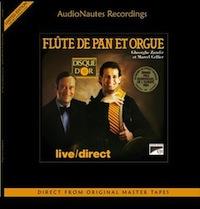Zamfir
Viewers of late night American television during the 1970s and 1980s surely know Romanian pan-flutist Zamfir. His albums were direct marketed all over the tube back then. The ads were kitschy, with Zamfir playing pan flute versions of standards. The vibe was Liberace on a pan flute—an image I apologize for leaving you with.
So if you remember that, forget that. If you don't remember that, ignore the first paragraph.
Perhaps you remember the classic Australian film by Peter Weir called "Picnic and Hanging Rock." He also did "The Last Wave" with Richard Chamberlain and "Gallipoli" with Mel (tdown) Gibson.
Music from this live album culled from concerts in Melbourne, Sidney, Adelaide and Perth Australia made its way onto the "Picnic at Hanging Rock" soundtrack.
Director Weir supposedly wanted original material performed by Zamfir and organist Cellier, whose wife (I assume) Catherine was the recording engineer for the original album issued on Cellier's own label. Zamfir didn't wish to produce new music so Weir used material from the album.
If you remember the movie—about the mysterious disappearance of a group of young school girls who are hypnotically drawn to an usual rock formation—you'll probably remember this music once you hear it. It's reminiscent of, but quite different than "The Emerald Forest" soundtrack The 1975 movie was eerie, mystical and unambiguously ambiguous, like many of Weir's movies. When you hear this haunting, ethereal, atmospheric record, you'll catch the vibe.
The recording was done on a Nagra 4S R2R deck using a pair of Neumann KM74 condensor microphones fed directly.
This reissue by Italian high end audio manufacturer AudioNautes uses the original master tape, which Stan Ricker used to cut 1/2 speed lacquers with playback via Studer, Telefunken and Nagra playback decks. Why three decks? Strictly for auditioning the tape on a variety of machines. Ricker used his own for the lacquer cut.
The story of how Cellier chose to create the pairing that led to this project and especially the technical aspects related to why hearing this is so moving and so hypnotic and so primal, is well told on the gatefold back jacket. Basically Cellier got Zamfir to play the violin part on a series of recordings Cellier had made of a popular Romanian violinist Efta Botoca fronting a string nonette playing long, sustained accords, with Cellier playing the part of the string section on the pipe organ.
The music is a series of long, atmospheric sustains on the organ that's felt as much as heard, over which Zamfir plays haunting, often unbearably sad overlays of the pan pipe wailing, mourning, sometimes squealing like a wounded animal, other times expressing beauty, envelopment, longing, contentment—an enormously wide variety of emotions brought forth by an instrument whose range is almost maddeningly limited.
The live recordings are absolutely spectacular: spacious, three-dimensional and transparent, with deep organ notes contrasting the pan pipe way above. If your system has real bottom end, this record will take you there. The dynamics are unbelievable. Even the applause is good!
Stan Ricker does a great job cutting this difficult recording. As he explains in the liner notes, Zamfir moves around between the mikes and his flute is not always in phase. When it goes out of phase it induces cutter head vertical modulations that Ricker felt were preferable to dropping the maximum possible levels to avoid tracking issues on less than optimized systems. Ricker sort of apologizes for the mistracking by writing that this is "...an example of a recording that has greater dynamic range than any consumer medium can contain."
My turntable had no trouble tracking it and if yours is set up correctly, it shouldn't either, though at timed Zamfir appears to be flying across the soundstage and back at speeds that should have snapped his neck! The lacquer plating was at RTI with pressing at Pallas. So you have a great minimalist two track analog audiophile recording mastered by Stan Ricker on a Neumann cutting system with custom electronics by Keith O. Johnson.
That's really all you need to know about the sound. As for the near-eastern mystical Romanian music, if it's in your soul it will come out. If it's not, it might get in after a few listens, so be prepared!
If you like this, consider Norwegian organist Iver Kleive's and guitarist Knut Reiersrud's Himmelskip recorded all-analog in a massive Danish church. It's an electric guitar and organ doing something similar to this album but sounding more like new age Pink Floyd. The spacious analog recording is stupendous, particularly if your rig does deep bass and wide dynamics.

If I were recommending a second vinyl release to the AudioNatues folks, it would be this! In fact I'll email them right now!



